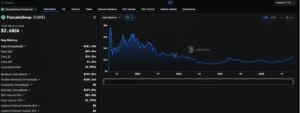US Shutdown Boosts Yen’s Safe-Haven Appeal. Forecast as of 01.10.2025

If monetary policy divergence does not work well for the Japanese currency, the yen’s strength may be bolstered by escalating political risks in the US. The growing demand for safe-haven assets has supported USDJPY bears. Let’s discuss this topic and develop a trading plan.
The article covers the following subjects:
Major Takeaways
- The US shutdown has boosted the yen.
- Bets on monetary policy divergence are surging.
- US tariffs will slow Japan’s GDP.
- Short trades on the USDJPY pair can be opened with targets of 145.5 and 143.3.
Weekly Fundamental Forecast for Yen
If monetary policy divergence does not support the yen, it may be beneficial to join the USDJPY bears’ camp. The recent decline in Treasury yields, driven by concerns over a slowdown in the US economy, indicates a growing demand for safe-haven assets. The US dollar is unlikely to assume this role, making the Japanese yen the optimal choice in the Forex market.
While Japan chooses a new prime minister and assesses the impact on monetary policy, external shocks have given the green light to USDJPY bears. The US economy was already experiencing a slowdown, and now there is a shutdown. Against this backdrop, it may be advantageous to consider purchasing the yen. However, investors overlook the slowdown in US GDP, which poses a significant obstacle for the BoJ on its path to monetary policy normalization.
At the September meeting of the Governing Board, only one official noted that it was time to consider raising the overnight rate. Meanwhile, the majority admitted that the full extent of the slowdown in the US economy remained uncertain, so it was appropriate for the central bank not to act in haste. Japan cannot rely on domestic demand to offset its export prospects. Sticky inflation is eroding wage growth, which is hindering consumer spending.
BoJ Rate Trajectory and Japanese Yen Swaps
Source: Bloomberg.
Moody’s Analytics anticipates that US tariffs will subtract 0.5 percentage points from Japan’s GDP in 2025, limiting the Bank of Japan’s monetary expansion. The company projects that the BoJ will make a rate hike in January. According to the Bank for International Settlements (BIS), bets on monetary policy divergence have led to a significant increase in yen derivative trading on Forex, reaching nearly eight times the volume seen in 2022.
The downward trend in USDJPY is primarily driven by the divergence in the path of the Fed’s and the Bank of Japan’s key interest rates. At the same time, it is essential to consider not only the direction of borrowing costs in the two countries, but also the speed at which they are changing. The Bank of Japan’s reluctance to tighten monetary policy is exerting pressure on the yen. Conversely, the Fed’s caution is helping the US dollar. If we consider political turmoil among other fundamental factors, the fluctuations in the USDJPY pair become more apparent.
History shows that shutdowns tend to put pressure on the US dollar. For instance, following the previous US government shutdown, the USDJPY pair slumped by approximately 1.5%. The current situation could be exacerbated by Donald Trump’s intention to reduce staff and the Democrats’ previously implemented programs. In addition, the current shutdown will likely be a full one.
Weekly USDJPY Trading Plan
In such conditions, it is better to adhere to the USDJPY sales strategy. Short trades formed on a rebound from the resistance level of 149.9 can be kept open and increased on pullbacks. The bearish targets are 145.5 and 143.3.
This forecast is based on the analysis of fundamental factors, including official statements from financial institutions and regulators, various geopolitical and economic developments, and statistical data. Historical market data are also considered.
Price chart of USDJPY in real time mode
The content of this article reflects the author’s opinion and does not necessarily reflect the official position of LiteFinance broker. The material published on this page is provided for informational purposes only and should not be considered as the provision of investment advice for the purposes of Directive 2014/65/EU.
According to copyright law, this article is considered intellectual property, which includes a prohibition on copying and distributing it without consent.







